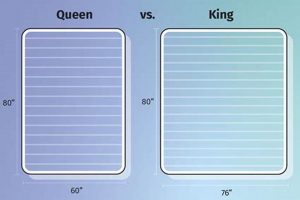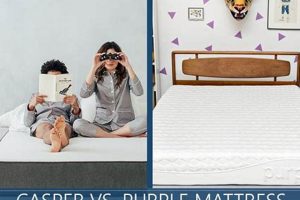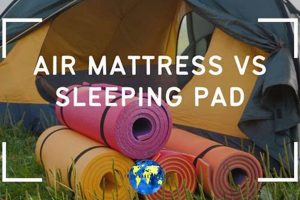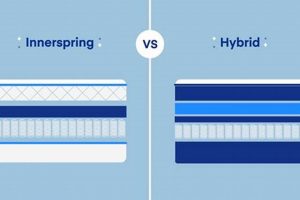The comparison involves two prevalent mattress types differentiated by their core construction and resulting feel. One utilizes a system of metal coils for support, while the other employs viscoelastic foam known for its conforming properties. These materials offer distinct sleep experiences catering to varying preferences.
Selecting the appropriate sleep surface is vital for spinal alignment, pressure relief, and overall sleep quality. Historically, innerspring designs dominated the market, but advancements in material science led to the increased popularity of foam alternatives, each presenting unique advantages in terms of support, motion isolation, and temperature regulation.
The subsequent sections will delve into a detailed examination of the characteristics of each type, covering factors such as support mechanisms, durability considerations, and thermal properties. This will empower individuals to make informed decisions based on their specific needs and preferences.
Selection Guidance
The process of choosing the ideal sleep surface necessitates careful consideration of individual needs and preferences. The following guidance is intended to facilitate a well-informed decision.
Tip 1: Assess Sleeping Position: Individuals who primarily sleep on their side may benefit from the conforming properties of viscoelastic foam, which can alleviate pressure on hips and shoulders. Stomach sleepers may find the firmer support of a coil-based design more conducive to spinal alignment.
Tip 2: Consider Body Weight: Heavier individuals often require a more robust support system. Innerspring models with a lower gauge coil may offer better long-term support. High-density foam alternatives can also provide adequate support but should be evaluated for durability.
Tip 3: Evaluate Temperature Sensitivity: Viscoelastic foam is known to retain heat, potentially leading to discomfort for warm sleepers. Open-cell foam constructions and gel infusions may mitigate this issue. Innerspring designs generally offer superior airflow and cooler sleep.
Tip 4: Account for Motion Transfer: If sharing the bed, consider the degree of motion isolation. Viscoelastic foam excels at absorbing movement, minimizing disturbance to a sleeping partner. Individually pocketed coils in innerspring designs can also reduce motion transfer.
Tip 5: Examine Edge Support: Edge support is critical for individuals who sit on the edge of the bed or require assistance getting in and out. Innerspring mattresses often feature reinforced edges. Foam models may exhibit less robust edge support, especially in lower-density constructions.
Tip 6: Research Durability Expectations: The lifespan varies. Innerspring durability is linked to coil gauge and construction. Foam degradation depends on foam density and quality. Research warranties and review independent product tests.
Tip 7: Test Before Purchase: Whenever feasible, test potential options in person. Spend at least 10-15 minutes lying on each option in various sleeping positions to assess comfort and support.
Careful evaluation of these factors will contribute to a more satisfying purchasing decision, leading to improved sleep quality and overall well-being.
The final determination should align with individual needs and prioritize long-term satisfaction.
1. Support and Responsiveness
Support and responsiveness are fundamental characteristics influencing sleep quality. In the context of differing mattress types, these attributes dictate how the sleep surface interacts with the body, affecting spinal alignment and ease of movement.
- Coil System Variations
Innerspring mattresses employ varying coil configurations, such as Bonnell, offset, or pocketed coils. Bonnell coils, an older design, offer a more uniform but less contouring support. Pocketed coils, individually wrapped, provide more targeted support and reduced motion transfer. Coil gauge (thickness) affects firmness; lower gauges indicate firmer support. This variation allows for diverse support levels within the category.
- Foam Density and Indentation Load Deflection (ILD)
Foam mattresses, particularly memory foam, rely on density and ILD to determine support and responsiveness. Higher density foams offer greater support and durability. ILD measures the firmness of the foam; higher ILD values signify firmer surfaces. The interplay between these factors governs the degree to which the mattress conforms and responds to pressure.
- Hybrid Designs
Hybrid mattresses attempt to combine the benefits of both innerspring and foam technologies. They often feature a coil support core topped with layers of memory foam or latex. This design aims to provide the responsive support of coils with the pressure-relieving comfort of foam. The specific characteristics depend on the type and thickness of the foam layers and the coil system used.
- Influence on Spinal Alignment
Adequate support is crucial for maintaining proper spinal alignment during sleep. A mattress that is too soft can lead to spinal misalignment, while one that is too firm may create pressure points. The ideal level of support is subjective and depends on sleeping position, body weight, and individual preferences. Responsive surfaces facilitate adjustments in sleeping position, contributing to sustained comfort and reduced tossing and turning.
The interaction between these support mechanisms and their responsiveness dictates the overall comfort and suitability of a mattress. Understanding these differences allows for a more informed selection based on individual needs and preferences, ultimately impacting sleep quality and physical well-being.
2. Pressure Relief
Pressure relief, a crucial aspect of sleep comfort, is differentially addressed by spring mattresses and memory foam. The degree to which a mattress conforms to the body and redistributes weight dictates its ability to alleviate pressure points, primarily at the shoulders, hips, and knees. Insufficient pressure relief can lead to discomfort, pain, and disrupted sleep. Spring mattresses, particularly those with traditional interconnected coils, tend to offer less conforming support. The uniform resistance across the surface may create localized pressure points, especially for side sleepers. By contrast, memory foam is designed to contour closely to the body, distributing weight over a larger surface area and reducing peak pressure at sensitive points. This conforming ability is particularly beneficial for individuals with joint pain, arthritis, or other conditions aggravated by pressure. For example, an individual with hip pain might find that a spring mattress exacerbates their discomfort due to concentrated pressure, whereas a memory foam mattress could provide significant relief.
The effectiveness of pressure relief also depends on the specific materials and construction methods employed. High-density memory foam generally provides superior pressure relief compared to low-density foam. Similarly, innerspring mattresses with individually pocketed coils can offer more targeted pressure relief compared to those with interconnected coils, as the pocketed coils can move independently to conform to the body’s contours. Hybrid mattresses, combining foam layers with coil systems, represent a middle ground, aiming to balance the support of coils with the pressure-relieving properties of foam. The practical significance of understanding these differences lies in the ability to select a mattress that mitigates pressure-related discomfort, promoting more restful and restorative sleep. Consider the example of a person who moves a lot while sleeping versus a person who stays relatively still. A spring mattress may lead to a disturbance and pressure points in the later case, while a memory foam will adapt and conform. Another aspect is body weight. Higher body weight would mean more pressure point and it is important to consider high density memory form in this example.
In summary, the pressure relief characteristics of spring mattresses and memory foam differ significantly, impacting sleep comfort and pain management. Memory foam generally excels at conforming to the body and alleviating pressure points, while spring mattresses may offer less targeted support. Hybrid designs attempt to combine the benefits of both. The choice between these options should be based on individual needs and preferences, considering factors such as sleeping position, body weight, and the presence of any pressure-sensitive conditions. Addressing pressure relief is not simply a matter of comfort; it is integral to promoting healthy sleep and overall well-being.
3. Temperature Regulation
Temperature regulation is a critical factor in achieving restful sleep. The ability of a mattress to dissipate heat and maintain a comfortable sleeping temperature significantly influences sleep quality. Different mattress types, specifically spring mattresses and memory foam, exhibit distinct thermal properties that warrant careful consideration.
- Airflow and Material Composition
Spring mattresses, due to their internal structure, generally offer greater airflow compared to memory foam. The open space within the coil system facilitates ventilation, allowing heat to dissipate more readily. Memory foam, conversely, tends to retain heat due to its dense, closed-cell structure. The specific materials used also play a role; some foams are engineered with open-cell technology or infused with cooling gels to improve breathability. For example, a traditional innerspring mattress allows air to circulate, preventing heat buildup, whereas a standard memory foam mattress may trap heat, leading to discomfort for some individuals. The choice is determined by an individual’s thermoregulation tendency.
- Heat Retention Properties
Memory foam’s heat retention stems from its viscoelastic properties, which allow it to conform closely to the body. This close contact restricts airflow and can lead to increased skin temperature. While beneficial for individuals who prefer a warmer sleeping environment, it can be problematic for those prone to overheating. Spring mattresses, with their reduced surface contact, minimize heat retention. This is particularly relevant in warmer climates or for individuals experiencing night sweats. The reduced contact is achieved through innerspring system which can be a benefit on its own.
- Cooling Technologies and Innovations
Manufacturers have introduced various cooling technologies to mitigate the heat retention issues associated with memory foam. These include open-cell foam structures, gel infusions, phase-change materials, and ventilation channels. Open-cell foam allows for improved airflow, while gel infusions draw heat away from the body. Phase-change materials absorb and release heat to maintain a consistent temperature. Ventilation channels promote air circulation within the foam. These innovations aim to enhance the thermal performance of memory foam and make it a more viable option for warm sleepers.
- Influence of Mattress Cover and Bedding
The mattress cover and bedding also contribute to temperature regulation. Breathable materials, such as cotton or bamboo, promote airflow and reduce heat buildup. Conversely, synthetic materials can trap heat and exacerbate discomfort. Selecting appropriate bedding can complement the thermal properties of the mattress and further optimize the sleeping environment. For example, even if a spring mattress is used, using non-breathable materials can still cause discomfort and trapping heat.
In summary, temperature regulation represents a significant differentiator between spring mattresses and memory foam. Spring mattresses inherently offer greater airflow and reduced heat retention, while memory foam tends to retain heat. However, advancements in foam technology and the use of appropriate bedding can mitigate these differences. Individuals should carefully consider their thermal preferences and environmental factors when selecting a mattress to ensure a comfortable and restful sleep experience. Hybrid also comes as an option which combines both mattress material, however it is important to consider a higher cost in this case.
4. Motion Isolation
Motion isolation, a critical attribute for undisturbed sleep, is a significant differentiator when comparing spring mattresses and memory foam. This characteristic refers to a mattress’s ability to minimize the transfer of movement across its surface. A high degree of motion isolation prevents one sleeper’s movements from disturbing another, contributing to improved sleep quality for both individuals. The construction materials of each mattress type directly influence motion transfer. Spring mattresses, especially those with interconnected coil systems, tend to exhibit greater motion transfer. Movement on one side of the bed can propagate through the interconnected coils, creating a ripple effect that disturbs a sleeping partner. This occurs because the coils act as a single unit, transmitting force across the surface. For instance, if one individual gets out of bed, the other may feel a noticeable jolt or disturbance. The practical significance of this is heightened for individuals who are light sleepers or couples with different sleep schedules. Memory foam, by contrast, excels at motion isolation. Its dense, viscoelastic structure absorbs movement at the point of impact, preventing it from spreading across the mattress surface. This localized response minimizes disturbance to a sleeping partner. The conforming nature of memory foam also helps to dampen vibrations, further reducing motion transfer. A real-world example would be a couple where one partner tends to toss and turn frequently; a memory foam mattress could significantly reduce the other partner’s awareness of these movements, leading to more restful sleep.
The level of motion isolation can be further enhanced by specific design features within each mattress type. In innerspring mattresses, individually pocketed coils offer improved motion isolation compared to traditional interconnected coils. Pocketed coils move independently, minimizing the transmission of movement. The gauge (thickness) and arrangement of the coils also play a role. In memory foam mattresses, higher density foams generally provide better motion isolation than lower density foams. The thickness and layering of the foam can also influence its ability to absorb movement. Hybrid mattresses, which combine coils and foam, aim to balance support with motion isolation. The performance of a hybrid design depends on the specific types and arrangement of the coils and foam layers. The strategic combination of both materials can significantly reduce overall motion transfer, however, it is important to test and find the right combination that minimizes motion transfer.
In conclusion, motion isolation is a crucial consideration in the selection of a mattress, particularly for couples. Memory foam generally provides superior motion isolation compared to spring mattresses, due to its dense, conforming structure. However, innerspring mattresses with pocketed coils can offer improved motion isolation compared to those with interconnected coils. The choice between these options should be based on individual needs and preferences, considering factors such as sleep sensitivity, sleeping habits, and the desired level of disturbance-free sleep. Effective motion isolation can significantly improve sleep quality and overall relationship harmony, as it minimizes sleep disruptions caused by a partner’s movements. The ability to remain undisturbed throughout the night is invaluable for restorative rest and long-term well-being.
5. Durability Comparison
Durability is a key determinant in the long-term value proposition of any mattress, directly influencing the lifespan and overall cost-effectiveness of spring mattress and memory foam options. The inherent material properties and construction methods of each type lead to distinct degradation patterns and expected lifespans. The coil system within a spring mattress is susceptible to wear and tear over time. Repeated compression can lead to coil fatigue, resulting in sagging, reduced support, and ultimately, diminished comfort. The quality of the steel used in the coils, as well as the coil gauge (thickness), influences the system’s resistance to deformation. Thicker coils generally exhibit greater durability than thinner coils. Furthermore, the presence of a robust border wire to support the perimeter of the mattress affects edge support and overall structural integrity. The lifespan can vary significantly; a low-quality spring mattress may only last five to seven years, while a well-constructed model with high-gauge coils and reinforced edges could last eight to ten years or more. In the context of heavy use, the rate of degradation accelerates. For example, in a hotel setting, spring mattresses typically require more frequent replacement compared to residential use.
Conversely, memory foam degradation manifests differently. The primary concern is the gradual loss of density and support, often referred to as “softening” or “indentation.” This occurs due to the breakdown of the foam’s cellular structure under repeated compression. The density of the foam is a critical factor affecting its durability. Higher density foams resist compression and deformation more effectively than lower density foams. Additionally, the quality of the foam’s raw materials and the manufacturing process influence its long-term performance. High-quality memory foam can maintain its support and comfort characteristics for seven to ten years or more, while lower quality options may exhibit significant softening within a few years. Temperature fluctuations and humidity levels can also accelerate foam degradation. Regular rotation of the mattress can help to distribute wear more evenly, extending its lifespan. Consider a scenario where a side sleeper consistently lies in the same position on a low-density memory foam mattress; localized softening is likely to occur more rapidly, leading to uneven support and discomfort. The practicality is that selecting a high-density memory foam mattress is an investment into the long-run to consider.
In summary, the durability profiles of spring mattresses and memory foam differ substantially. Spring mattresses are primarily susceptible to coil fatigue and sagging, while memory foam is prone to softening and indentation. The lifespan of each type is influenced by material quality, construction methods, usage patterns, and environmental factors. Understanding these differences is essential for making an informed purchasing decision that aligns with individual needs, budget considerations, and long-term expectations. While a high-quality spring mattress or memory foam mattress may require a greater initial investment, its extended lifespan and consistent performance can ultimately provide a superior return on investment compared to a lower quality, less durable alternative. Regular maintenance, such as rotation and the use of a mattress protector, can further extend the lifespan of any mattress type, regardless of its construction. Comparing these key factors such as materials, usage, and maintenance helps find the more durable options for “spring mattress vs memory foam”.
Frequently Asked Questions
The following section addresses common inquiries regarding the comparative characteristics of spring and memory foam mattresses, providing concise and informative answers to aid in informed decision-making.
Question 1: Are spring mattresses inherently cooler than memory foam?
Generally, yes. The open structure of a spring mattress allows for greater airflow, promoting heat dissipation. Memory foam tends to retain more heat due to its denser composition, although newer technologies like gel infusions attempt to mitigate this.
Question 2: Which mattress type offers superior support for individuals with back pain?
The optimal choice depends on individual spinal alignment needs. Memory foam conforms closely to the body, potentially providing targeted pressure relief. Spring mattresses, particularly those with pocketed coils, can offer more robust and consistent support. Consulting a healthcare professional is advisable for personalized recommendations.
Question 3: How does motion transfer differ between spring and memory foam mattresses?
Memory foam typically exhibits lower motion transfer due to its ability to absorb movement at the point of impact. Spring mattresses, especially those with interconnected coils, tend to transmit more motion across the surface.
Question 4: What is the expected lifespan of a spring mattress compared to a memory foam mattress?
Lifespan varies based on material quality and usage. However, a high-quality spring or memory foam mattress can last approximately seven to ten years. Regular rotation and proper support can extend the lifespan of either type.
Question 5: Do all memory foam mattresses retain heat?
Traditional memory foam is known for heat retention. However, advancements in foam technology have led to the development of open-cell and gel-infused memory foams designed to improve breathability and reduce heat buildup.
Question 6: Are spring mattresses more durable than memory foam mattresses?
Durability depends on the quality of construction and materials. Spring mattresses are susceptible to coil fatigue, while memory foam can experience softening over time. Both types can offer comparable durability if well-constructed and properly maintained.
Careful consideration of individual needs and preferences remains paramount in the selection process. These key questions should aid in your final decision between “spring mattress vs memory foam”
The following section will conclude with actionable insights, summarizing the information presented and reinforcing the importance of personalized decision-making.
Concluding Remarks
This exploration of spring mattress vs memory foam underscores the nuanced differences in construction, performance, and suitability for diverse sleep needs. Factors such as support, pressure relief, temperature regulation, motion isolation, and durability each contribute uniquely to the overall sleep experience, requiring careful consideration of individual preferences and requirements.
Ultimately, the optimal selection necessitates a thorough assessment of personal sleep habits and priorities. Informed decision-making, guided by a comprehensive understanding of the inherent characteristics of each mattress type, is essential for maximizing sleep quality and promoting long-term well-being. Continued research and technological advancements promise further refinements in mattress design, potentially blurring the lines between traditional categories and offering increasingly personalized sleep solutions.







![Saatva vs Leesa Mattress: Which Bed Wins? [2024] Organic & Natural Mattress Buyer’s Guide: Non-Toxic Sleep Solutions Saatva vs Leesa Mattress: Which Bed Wins? [2024] | Organic & Natural Mattress Buyer’s Guide: Non-Toxic Sleep Solutions](https://mattressworldpa.com/wp-content/uploads/2025/07/th-1084-300x200.jpg)